Organisational Behaviour Report: Impact of Culture, Politics & Power
VerifiedAdded on 2020/10/22
|14
|4185
|403
Report
AI Summary
This report provides a comprehensive analysis of organisational behaviour within the context of A David & Co. Ltd. It begins by defining organisational behaviour and then delves into the impact of culture, politics, and power on employee performance, referencing Handy's cultural model. The report then evaluates individual and team motivation, exploring theories such as Maslow's hierarchy of needs, Herzberg's two-factor theory, equity theory, and expectancy theory, along with the concepts of intrinsic and extrinsic motivation. The report also discusses the factors that contribute to effective teams. Finally, it demonstrates the application of various leadership theories in different organisational situations. The report aims to provide a clear understanding of the factors influencing employee behaviour and organisational success.
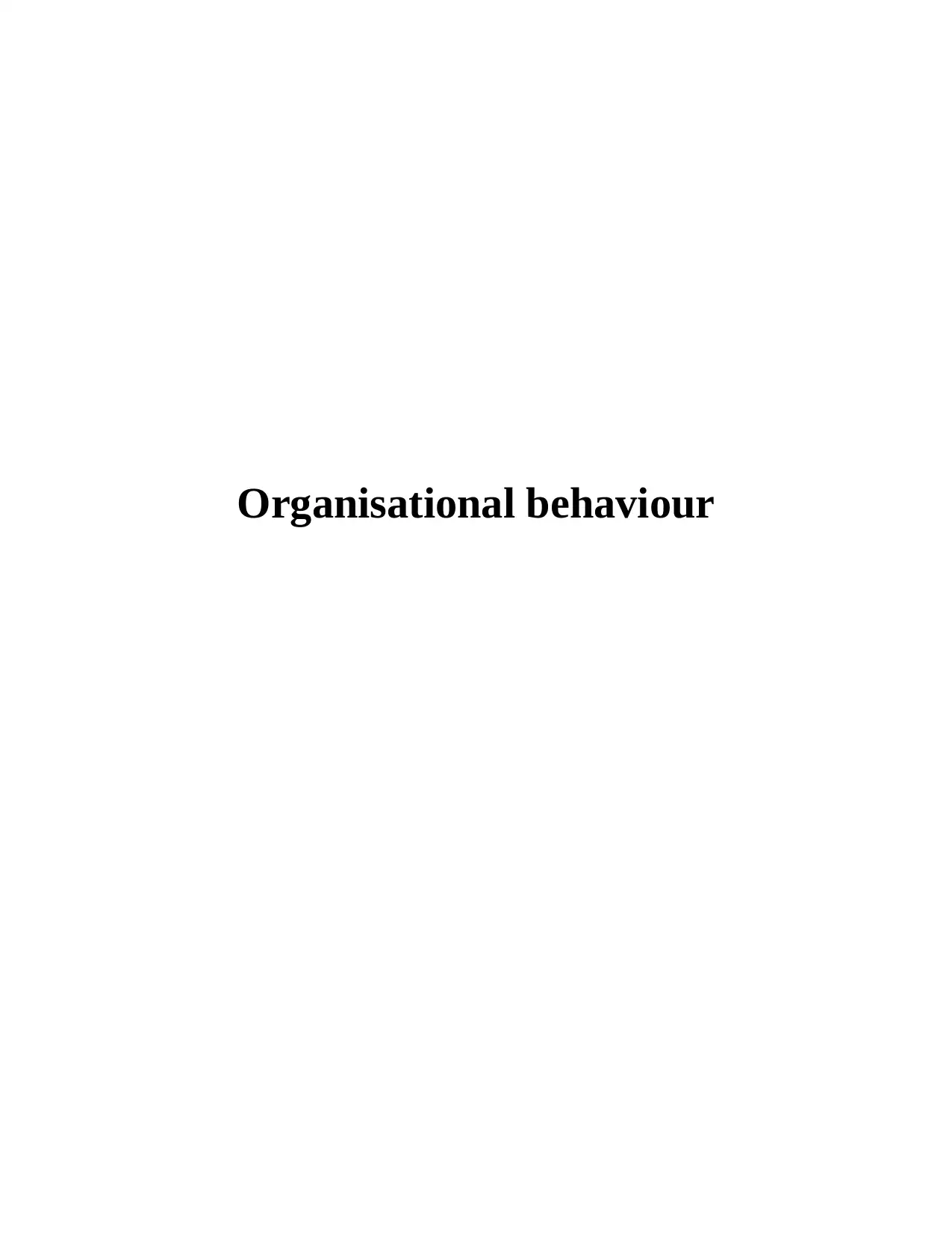
Organisational behaviour
Paraphrase This Document
Need a fresh take? Get an instant paraphrase of this document with our AI Paraphraser
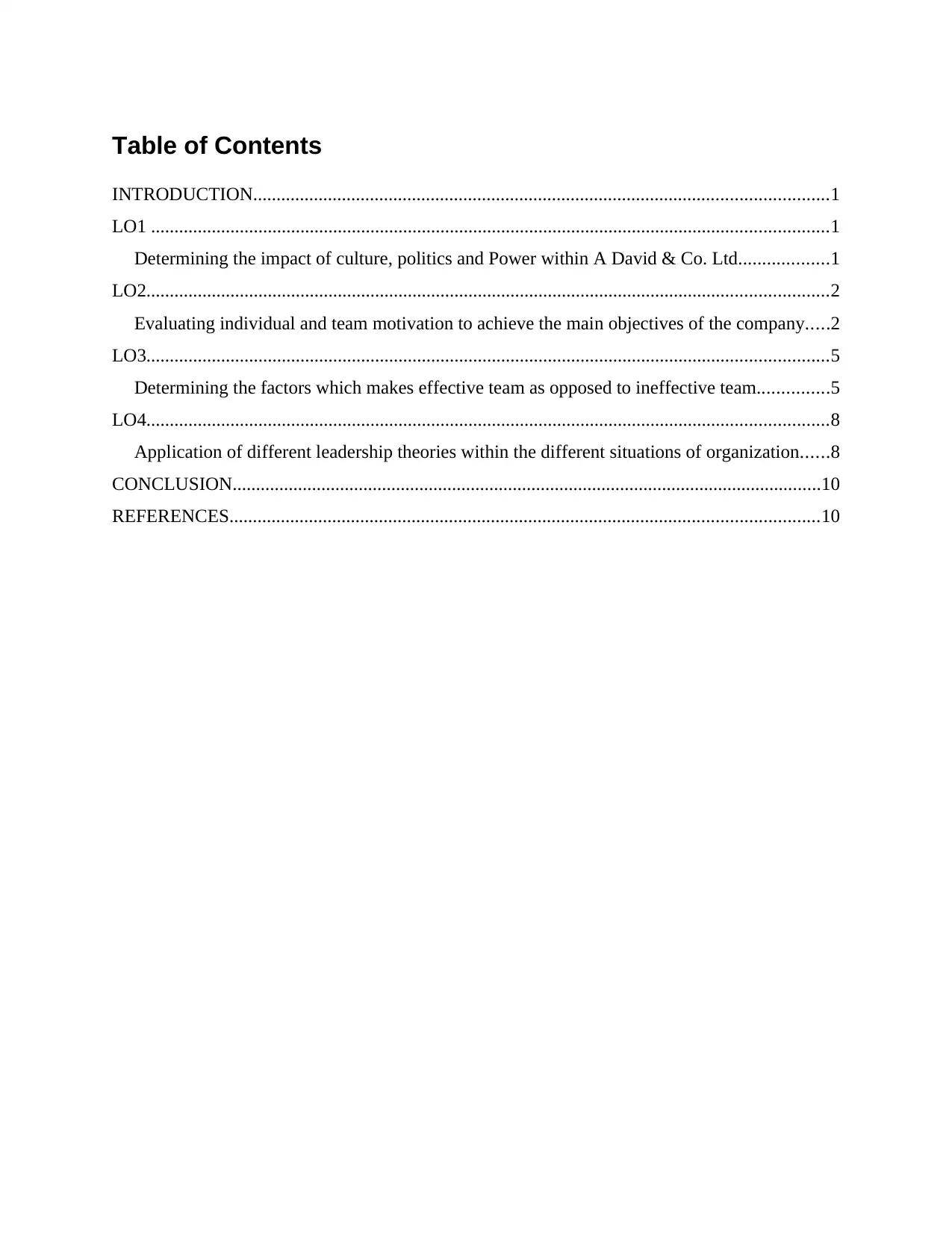
Table of Contents
INTRODUCTION...........................................................................................................................1
LO1 .................................................................................................................................................1
Determining the impact of culture, politics and Power within A David & Co. Ltd...................1
LO2..................................................................................................................................................2
Evaluating individual and team motivation to achieve the main objectives of the company.....2
LO3..................................................................................................................................................5
Determining the factors which makes effective team as opposed to ineffective team...............5
LO4..................................................................................................................................................8
Application of different leadership theories within the different situations of organization......8
CONCLUSION..............................................................................................................................10
REFERENCES..............................................................................................................................10
INTRODUCTION...........................................................................................................................1
LO1 .................................................................................................................................................1
Determining the impact of culture, politics and Power within A David & Co. Ltd...................1
LO2..................................................................................................................................................2
Evaluating individual and team motivation to achieve the main objectives of the company.....2
LO3..................................................................................................................................................5
Determining the factors which makes effective team as opposed to ineffective team...............5
LO4..................................................................................................................................................8
Application of different leadership theories within the different situations of organization......8
CONCLUSION..............................................................................................................................10
REFERENCES..............................................................................................................................10
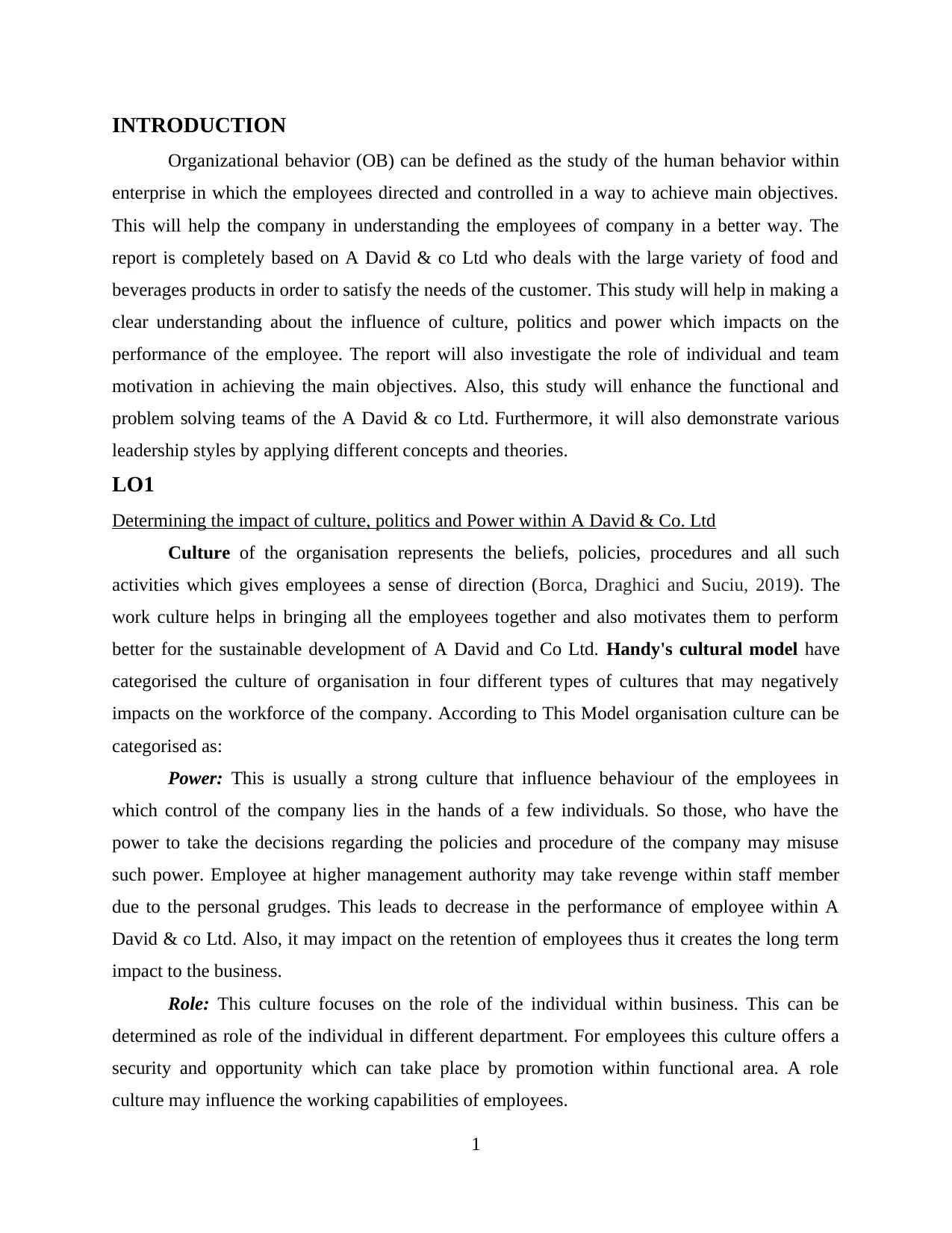
INTRODUCTION
Organizational behavior (OB) can be defined as the study of the human behavior within
enterprise in which the employees directed and controlled in a way to achieve main objectives.
This will help the company in understanding the employees of company in a better way. The
report is completely based on A David & co Ltd who deals with the large variety of food and
beverages products in order to satisfy the needs of the customer. This study will help in making a
clear understanding about the influence of culture, politics and power which impacts on the
performance of the employee. The report will also investigate the role of individual and team
motivation in achieving the main objectives. Also, this study will enhance the functional and
problem solving teams of the A David & co Ltd. Furthermore, it will also demonstrate various
leadership styles by applying different concepts and theories.
LO1
Determining the impact of culture, politics and Power within A David & Co. Ltd
Culture of the organisation represents the beliefs, policies, procedures and all such
activities which gives employees a sense of direction (Borca, Draghici and Suciu, 2019). The
work culture helps in bringing all the employees together and also motivates them to perform
better for the sustainable development of A David and Co Ltd. Handy's cultural model have
categorised the culture of organisation in four different types of cultures that may negatively
impacts on the workforce of the company. According to This Model organisation culture can be
categorised as:
Power: This is usually a strong culture that influence behaviour of the employees in
which control of the company lies in the hands of a few individuals. So those, who have the
power to take the decisions regarding the policies and procedure of the company may misuse
such power. Employee at higher management authority may take revenge within staff member
due to the personal grudges. This leads to decrease in the performance of employee within A
David & co Ltd. Also, it may impact on the retention of employees thus it creates the long term
impact to the business.
Role: This culture focuses on the role of the individual within business. This can be
determined as role of the individual in different department. For employees this culture offers a
security and opportunity which can take place by promotion within functional area. A role
culture may influence the working capabilities of employees.
1
Organizational behavior (OB) can be defined as the study of the human behavior within
enterprise in which the employees directed and controlled in a way to achieve main objectives.
This will help the company in understanding the employees of company in a better way. The
report is completely based on A David & co Ltd who deals with the large variety of food and
beverages products in order to satisfy the needs of the customer. This study will help in making a
clear understanding about the influence of culture, politics and power which impacts on the
performance of the employee. The report will also investigate the role of individual and team
motivation in achieving the main objectives. Also, this study will enhance the functional and
problem solving teams of the A David & co Ltd. Furthermore, it will also demonstrate various
leadership styles by applying different concepts and theories.
LO1
Determining the impact of culture, politics and Power within A David & Co. Ltd
Culture of the organisation represents the beliefs, policies, procedures and all such
activities which gives employees a sense of direction (Borca, Draghici and Suciu, 2019). The
work culture helps in bringing all the employees together and also motivates them to perform
better for the sustainable development of A David and Co Ltd. Handy's cultural model have
categorised the culture of organisation in four different types of cultures that may negatively
impacts on the workforce of the company. According to This Model organisation culture can be
categorised as:
Power: This is usually a strong culture that influence behaviour of the employees in
which control of the company lies in the hands of a few individuals. So those, who have the
power to take the decisions regarding the policies and procedure of the company may misuse
such power. Employee at higher management authority may take revenge within staff member
due to the personal grudges. This leads to decrease in the performance of employee within A
David & co Ltd. Also, it may impact on the retention of employees thus it creates the long term
impact to the business.
Role: This culture focuses on the role of the individual within business. This can be
determined as role of the individual in different department. For employees this culture offers a
security and opportunity which can take place by promotion within functional area. A role
culture may influence the working capabilities of employees.
1
⊘ This is a preview!⊘
Do you want full access?
Subscribe today to unlock all pages.

Trusted by 1+ million students worldwide
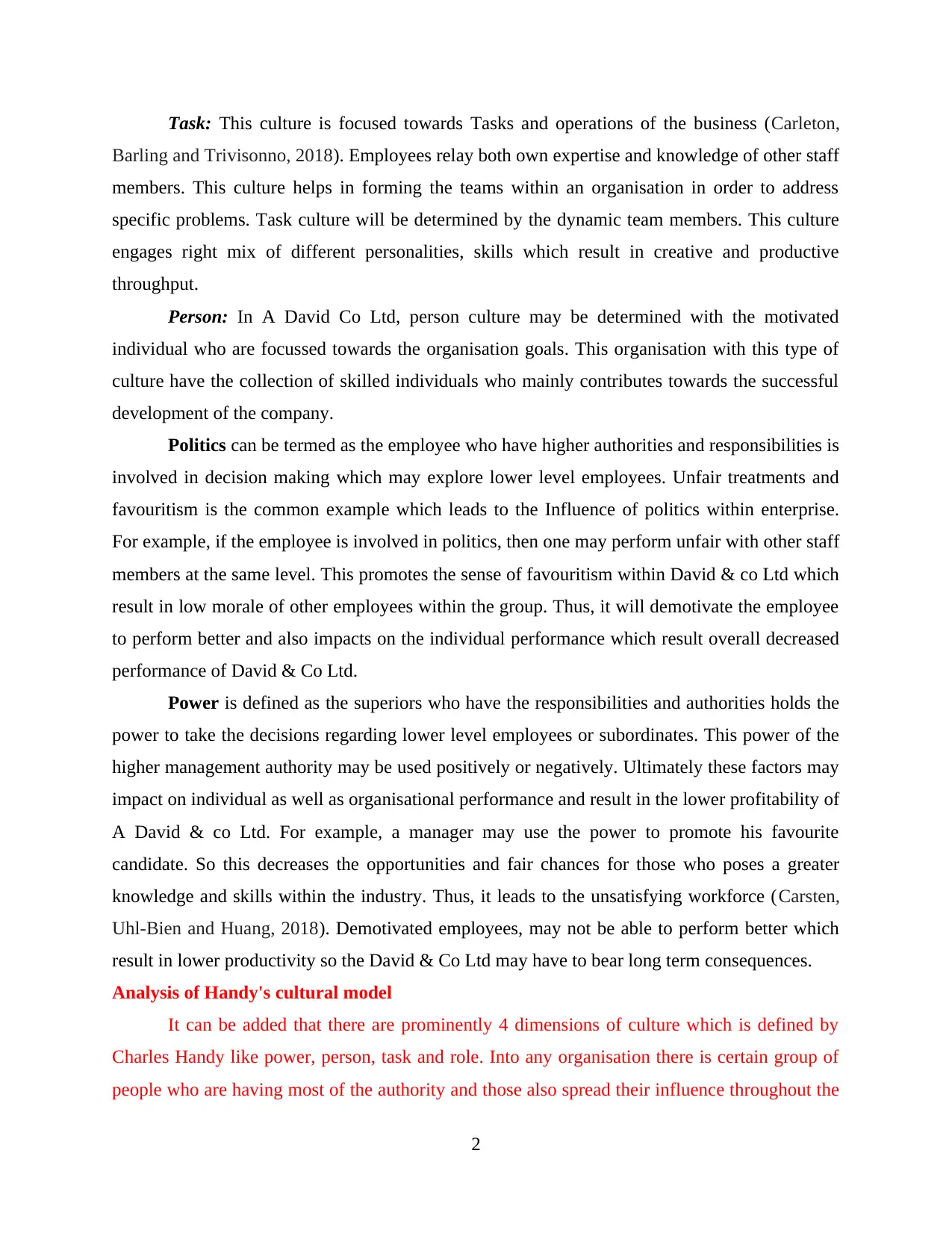
Task: This culture is focused towards Tasks and operations of the business (Carleton,
Barling and Trivisonno, 2018). Employees relay both own expertise and knowledge of other staff
members. This culture helps in forming the teams within an organisation in order to address
specific problems. Task culture will be determined by the dynamic team members. This culture
engages right mix of different personalities, skills which result in creative and productive
throughput.
Person: In A David Co Ltd, person culture may be determined with the motivated
individual who are focussed towards the organisation goals. This organisation with this type of
culture have the collection of skilled individuals who mainly contributes towards the successful
development of the company.
Politics can be termed as the employee who have higher authorities and responsibilities is
involved in decision making which may explore lower level employees. Unfair treatments and
favouritism is the common example which leads to the Influence of politics within enterprise.
For example, if the employee is involved in politics, then one may perform unfair with other staff
members at the same level. This promotes the sense of favouritism within David & co Ltd which
result in low morale of other employees within the group. Thus, it will demotivate the employee
to perform better and also impacts on the individual performance which result overall decreased
performance of David & Co Ltd.
Power is defined as the superiors who have the responsibilities and authorities holds the
power to take the decisions regarding lower level employees or subordinates. This power of the
higher management authority may be used positively or negatively. Ultimately these factors may
impact on individual as well as organisational performance and result in the lower profitability of
A David & co Ltd. For example, a manager may use the power to promote his favourite
candidate. So this decreases the opportunities and fair chances for those who poses a greater
knowledge and skills within the industry. Thus, it leads to the unsatisfying workforce (Carsten,
Uhl-Bien and Huang, 2018). Demotivated employees, may not be able to perform better which
result in lower productivity so the David & Co Ltd may have to bear long term consequences.
Analysis of Handy's cultural model
It can be added that there are prominently 4 dimensions of culture which is defined by
Charles Handy like power, person, task and role. Into any organisation there is certain group of
people who are having most of the authority and those also spread their influence throughout the
2
Barling and Trivisonno, 2018). Employees relay both own expertise and knowledge of other staff
members. This culture helps in forming the teams within an organisation in order to address
specific problems. Task culture will be determined by the dynamic team members. This culture
engages right mix of different personalities, skills which result in creative and productive
throughput.
Person: In A David Co Ltd, person culture may be determined with the motivated
individual who are focussed towards the organisation goals. This organisation with this type of
culture have the collection of skilled individuals who mainly contributes towards the successful
development of the company.
Politics can be termed as the employee who have higher authorities and responsibilities is
involved in decision making which may explore lower level employees. Unfair treatments and
favouritism is the common example which leads to the Influence of politics within enterprise.
For example, if the employee is involved in politics, then one may perform unfair with other staff
members at the same level. This promotes the sense of favouritism within David & co Ltd which
result in low morale of other employees within the group. Thus, it will demotivate the employee
to perform better and also impacts on the individual performance which result overall decreased
performance of David & Co Ltd.
Power is defined as the superiors who have the responsibilities and authorities holds the
power to take the decisions regarding lower level employees or subordinates. This power of the
higher management authority may be used positively or negatively. Ultimately these factors may
impact on individual as well as organisational performance and result in the lower profitability of
A David & co Ltd. For example, a manager may use the power to promote his favourite
candidate. So this decreases the opportunities and fair chances for those who poses a greater
knowledge and skills within the industry. Thus, it leads to the unsatisfying workforce (Carsten,
Uhl-Bien and Huang, 2018). Demotivated employees, may not be able to perform better which
result in lower productivity so the David & Co Ltd may have to bear long term consequences.
Analysis of Handy's cultural model
It can be added that there are prominently 4 dimensions of culture which is defined by
Charles Handy like power, person, task and role. Into any organisation there is certain group of
people who are having most of the authority and those also spread their influence throughout the
2
Paraphrase This Document
Need a fresh take? Get an instant paraphrase of this document with our AI Paraphraser
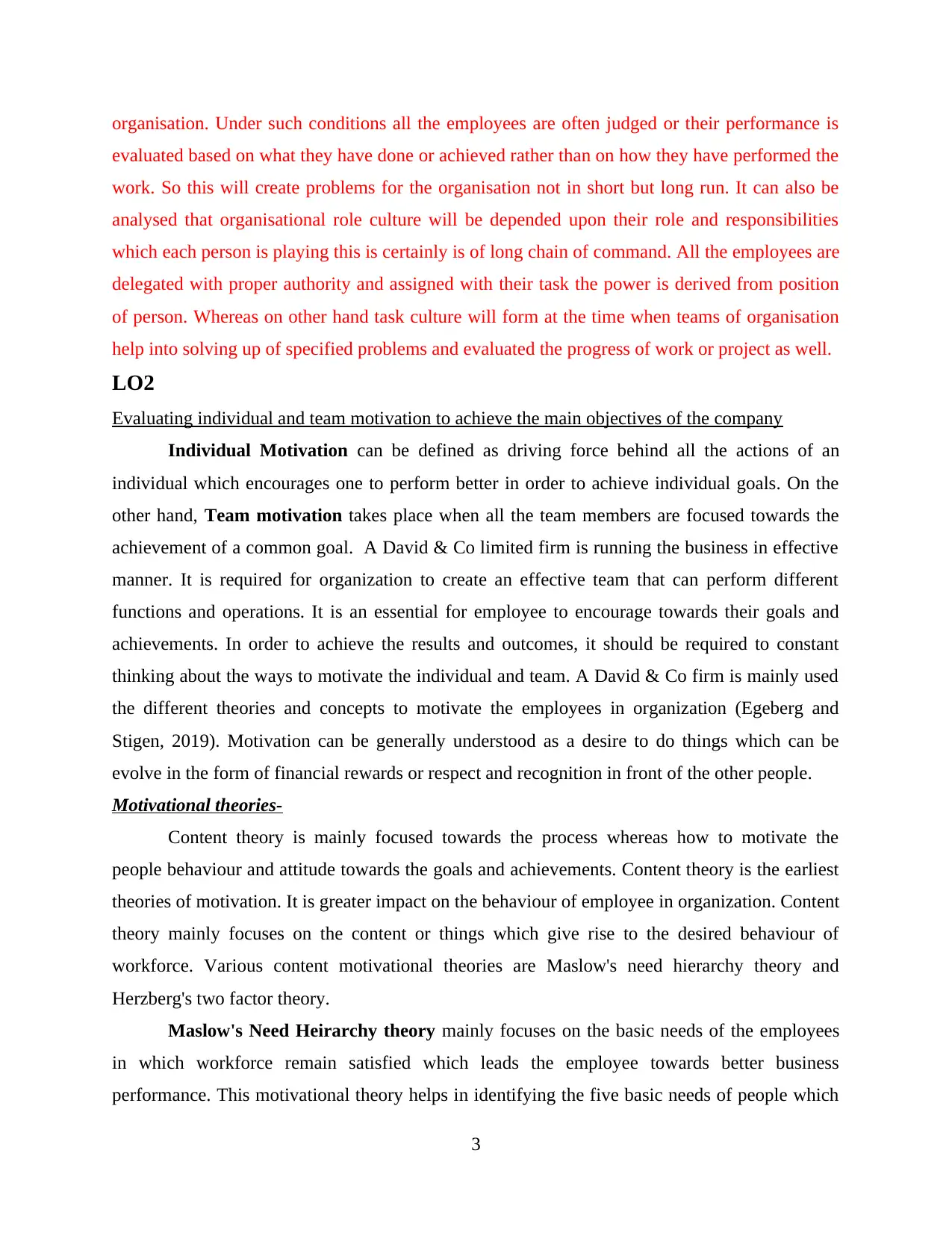
organisation. Under such conditions all the employees are often judged or their performance is
evaluated based on what they have done or achieved rather than on how they have performed the
work. So this will create problems for the organisation not in short but long run. It can also be
analysed that organisational role culture will be depended upon their role and responsibilities
which each person is playing this is certainly is of long chain of command. All the employees are
delegated with proper authority and assigned with their task the power is derived from position
of person. Whereas on other hand task culture will form at the time when teams of organisation
help into solving up of specified problems and evaluated the progress of work or project as well.
LO2
Evaluating individual and team motivation to achieve the main objectives of the company
Individual Motivation can be defined as driving force behind all the actions of an
individual which encourages one to perform better in order to achieve individual goals. On the
other hand, Team motivation takes place when all the team members are focused towards the
achievement of a common goal. A David & Co limited firm is running the business in effective
manner. It is required for organization to create an effective team that can perform different
functions and operations. It is an essential for employee to encourage towards their goals and
achievements. In order to achieve the results and outcomes, it should be required to constant
thinking about the ways to motivate the individual and team. A David & Co firm is mainly used
the different theories and concepts to motivate the employees in organization (Egeberg and
Stigen, 2019). Motivation can be generally understood as a desire to do things which can be
evolve in the form of financial rewards or respect and recognition in front of the other people.
Motivational theories-
Content theory is mainly focused towards the process whereas how to motivate the
people behaviour and attitude towards the goals and achievements. Content theory is the earliest
theories of motivation. It is greater impact on the behaviour of employee in organization. Content
theory mainly focuses on the content or things which give rise to the desired behaviour of
workforce. Various content motivational theories are Maslow's need hierarchy theory and
Herzberg's two factor theory.
Maslow's Need Heirarchy theory mainly focuses on the basic needs of the employees
in which workforce remain satisfied which leads the employee towards better business
performance. This motivational theory helps in identifying the five basic needs of people which
3
evaluated based on what they have done or achieved rather than on how they have performed the
work. So this will create problems for the organisation not in short but long run. It can also be
analysed that organisational role culture will be depended upon their role and responsibilities
which each person is playing this is certainly is of long chain of command. All the employees are
delegated with proper authority and assigned with their task the power is derived from position
of person. Whereas on other hand task culture will form at the time when teams of organisation
help into solving up of specified problems and evaluated the progress of work or project as well.
LO2
Evaluating individual and team motivation to achieve the main objectives of the company
Individual Motivation can be defined as driving force behind all the actions of an
individual which encourages one to perform better in order to achieve individual goals. On the
other hand, Team motivation takes place when all the team members are focused towards the
achievement of a common goal. A David & Co limited firm is running the business in effective
manner. It is required for organization to create an effective team that can perform different
functions and operations. It is an essential for employee to encourage towards their goals and
achievements. In order to achieve the results and outcomes, it should be required to constant
thinking about the ways to motivate the individual and team. A David & Co firm is mainly used
the different theories and concepts to motivate the employees in organization (Egeberg and
Stigen, 2019). Motivation can be generally understood as a desire to do things which can be
evolve in the form of financial rewards or respect and recognition in front of the other people.
Motivational theories-
Content theory is mainly focused towards the process whereas how to motivate the
people behaviour and attitude towards the goals and achievements. Content theory is the earliest
theories of motivation. It is greater impact on the behaviour of employee in organization. Content
theory mainly focuses on the content or things which give rise to the desired behaviour of
workforce. Various content motivational theories are Maslow's need hierarchy theory and
Herzberg's two factor theory.
Maslow's Need Heirarchy theory mainly focuses on the basic needs of the employees
in which workforce remain satisfied which leads the employee towards better business
performance. This motivational theory helps in identifying the five basic needs of people which
3
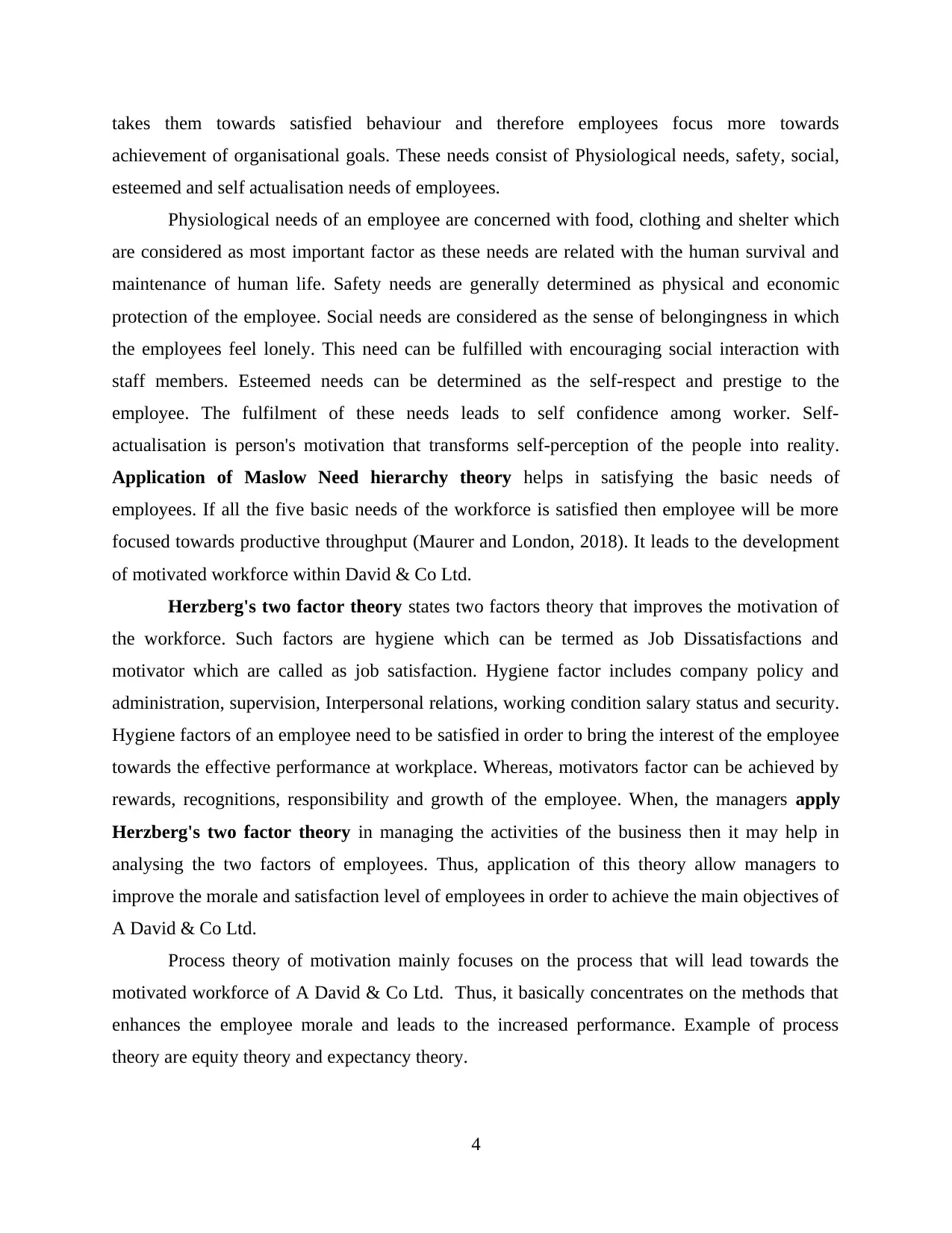
takes them towards satisfied behaviour and therefore employees focus more towards
achievement of organisational goals. These needs consist of Physiological needs, safety, social,
esteemed and self actualisation needs of employees.
Physiological needs of an employee are concerned with food, clothing and shelter which
are considered as most important factor as these needs are related with the human survival and
maintenance of human life. Safety needs are generally determined as physical and economic
protection of the employee. Social needs are considered as the sense of belongingness in which
the employees feel lonely. This need can be fulfilled with encouraging social interaction with
staff members. Esteemed needs can be determined as the self-respect and prestige to the
employee. The fulfilment of these needs leads to self confidence among worker. Self-
actualisation is person's motivation that transforms self-perception of the people into reality.
Application of Maslow Need hierarchy theory helps in satisfying the basic needs of
employees. If all the five basic needs of the workforce is satisfied then employee will be more
focused towards productive throughput (Maurer and London, 2018). It leads to the development
of motivated workforce within David & Co Ltd.
Herzberg's two factor theory states two factors theory that improves the motivation of
the workforce. Such factors are hygiene which can be termed as Job Dissatisfactions and
motivator which are called as job satisfaction. Hygiene factor includes company policy and
administration, supervision, Interpersonal relations, working condition salary status and security.
Hygiene factors of an employee need to be satisfied in order to bring the interest of the employee
towards the effective performance at workplace. Whereas, motivators factor can be achieved by
rewards, recognitions, responsibility and growth of the employee. When, the managers apply
Herzberg's two factor theory in managing the activities of the business then it may help in
analysing the two factors of employees. Thus, application of this theory allow managers to
improve the morale and satisfaction level of employees in order to achieve the main objectives of
A David & Co Ltd.
Process theory of motivation mainly focuses on the process that will lead towards the
motivated workforce of A David & Co Ltd. Thus, it basically concentrates on the methods that
enhances the employee morale and leads to the increased performance. Example of process
theory are equity theory and expectancy theory.
4
achievement of organisational goals. These needs consist of Physiological needs, safety, social,
esteemed and self actualisation needs of employees.
Physiological needs of an employee are concerned with food, clothing and shelter which
are considered as most important factor as these needs are related with the human survival and
maintenance of human life. Safety needs are generally determined as physical and economic
protection of the employee. Social needs are considered as the sense of belongingness in which
the employees feel lonely. This need can be fulfilled with encouraging social interaction with
staff members. Esteemed needs can be determined as the self-respect and prestige to the
employee. The fulfilment of these needs leads to self confidence among worker. Self-
actualisation is person's motivation that transforms self-perception of the people into reality.
Application of Maslow Need hierarchy theory helps in satisfying the basic needs of
employees. If all the five basic needs of the workforce is satisfied then employee will be more
focused towards productive throughput (Maurer and London, 2018). It leads to the development
of motivated workforce within David & Co Ltd.
Herzberg's two factor theory states two factors theory that improves the motivation of
the workforce. Such factors are hygiene which can be termed as Job Dissatisfactions and
motivator which are called as job satisfaction. Hygiene factor includes company policy and
administration, supervision, Interpersonal relations, working condition salary status and security.
Hygiene factors of an employee need to be satisfied in order to bring the interest of the employee
towards the effective performance at workplace. Whereas, motivators factor can be achieved by
rewards, recognitions, responsibility and growth of the employee. When, the managers apply
Herzberg's two factor theory in managing the activities of the business then it may help in
analysing the two factors of employees. Thus, application of this theory allow managers to
improve the morale and satisfaction level of employees in order to achieve the main objectives of
A David & Co Ltd.
Process theory of motivation mainly focuses on the process that will lead towards the
motivated workforce of A David & Co Ltd. Thus, it basically concentrates on the methods that
enhances the employee morale and leads to the increased performance. Example of process
theory are equity theory and expectancy theory.
4
⊘ This is a preview!⊘
Do you want full access?
Subscribe today to unlock all pages.

Trusted by 1+ million students worldwide
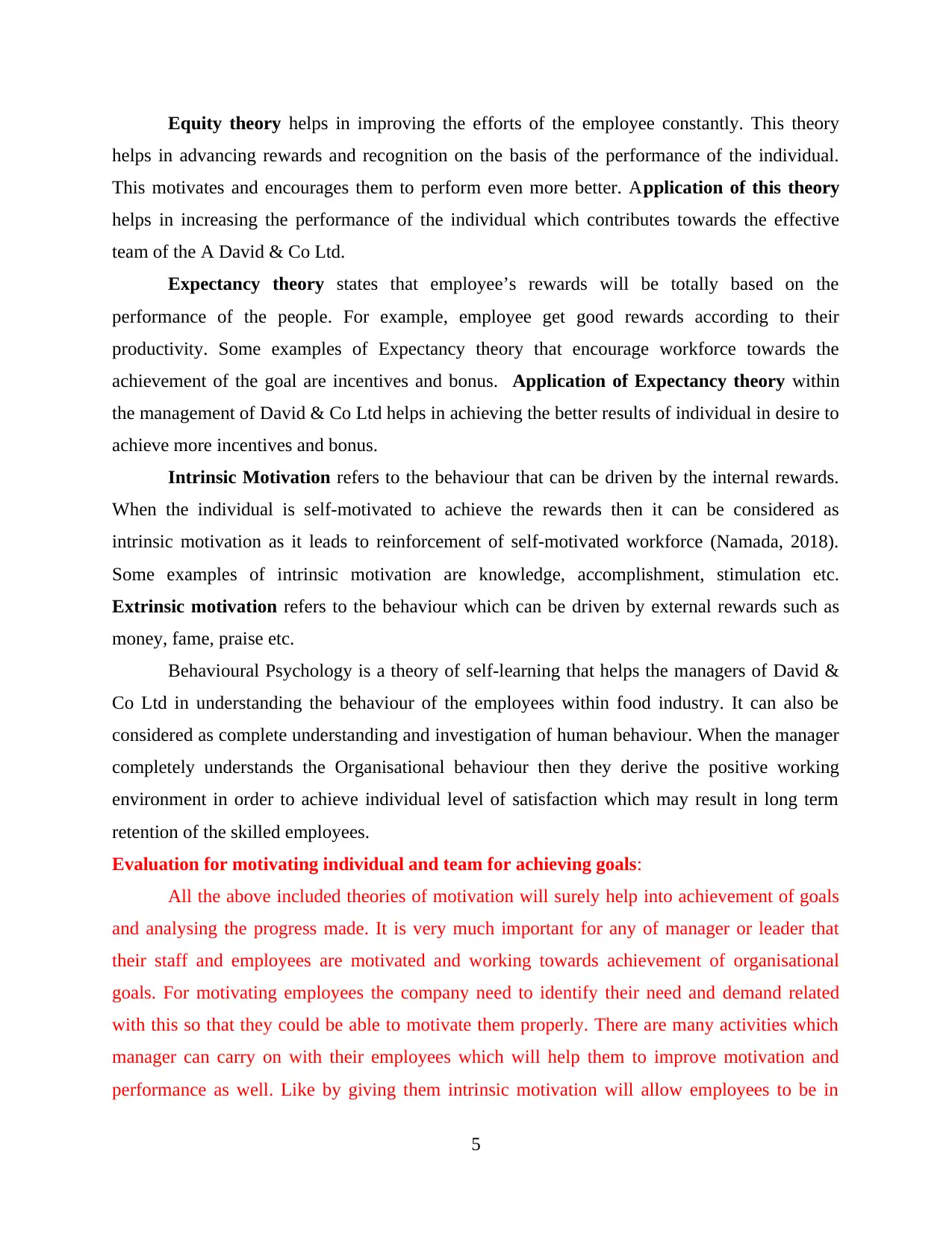
Equity theory helps in improving the efforts of the employee constantly. This theory
helps in advancing rewards and recognition on the basis of the performance of the individual.
This motivates and encourages them to perform even more better. Application of this theory
helps in increasing the performance of the individual which contributes towards the effective
team of the A David & Co Ltd.
Expectancy theory states that employee’s rewards will be totally based on the
performance of the people. For example, employee get good rewards according to their
productivity. Some examples of Expectancy theory that encourage workforce towards the
achievement of the goal are incentives and bonus. Application of Expectancy theory within
the management of David & Co Ltd helps in achieving the better results of individual in desire to
achieve more incentives and bonus.
Intrinsic Motivation refers to the behaviour that can be driven by the internal rewards.
When the individual is self-motivated to achieve the rewards then it can be considered as
intrinsic motivation as it leads to reinforcement of self-motivated workforce (Namada, 2018).
Some examples of intrinsic motivation are knowledge, accomplishment, stimulation etc.
Extrinsic motivation refers to the behaviour which can be driven by external rewards such as
money, fame, praise etc.
Behavioural Psychology is a theory of self-learning that helps the managers of David &
Co Ltd in understanding the behaviour of the employees within food industry. It can also be
considered as complete understanding and investigation of human behaviour. When the manager
completely understands the Organisational behaviour then they derive the positive working
environment in order to achieve individual level of satisfaction which may result in long term
retention of the skilled employees.
Evaluation for motivating individual and team for achieving goals:
All the above included theories of motivation will surely help into achievement of goals
and analysing the progress made. It is very much important for any of manager or leader that
their staff and employees are motivated and working towards achievement of organisational
goals. For motivating employees the company need to identify their need and demand related
with this so that they could be able to motivate them properly. There are many activities which
manager can carry on with their employees which will help them to improve motivation and
performance as well. Like by giving them intrinsic motivation will allow employees to be in
5
helps in advancing rewards and recognition on the basis of the performance of the individual.
This motivates and encourages them to perform even more better. Application of this theory
helps in increasing the performance of the individual which contributes towards the effective
team of the A David & Co Ltd.
Expectancy theory states that employee’s rewards will be totally based on the
performance of the people. For example, employee get good rewards according to their
productivity. Some examples of Expectancy theory that encourage workforce towards the
achievement of the goal are incentives and bonus. Application of Expectancy theory within
the management of David & Co Ltd helps in achieving the better results of individual in desire to
achieve more incentives and bonus.
Intrinsic Motivation refers to the behaviour that can be driven by the internal rewards.
When the individual is self-motivated to achieve the rewards then it can be considered as
intrinsic motivation as it leads to reinforcement of self-motivated workforce (Namada, 2018).
Some examples of intrinsic motivation are knowledge, accomplishment, stimulation etc.
Extrinsic motivation refers to the behaviour which can be driven by external rewards such as
money, fame, praise etc.
Behavioural Psychology is a theory of self-learning that helps the managers of David &
Co Ltd in understanding the behaviour of the employees within food industry. It can also be
considered as complete understanding and investigation of human behaviour. When the manager
completely understands the Organisational behaviour then they derive the positive working
environment in order to achieve individual level of satisfaction which may result in long term
retention of the skilled employees.
Evaluation for motivating individual and team for achieving goals:
All the above included theories of motivation will surely help into achievement of goals
and analysing the progress made. It is very much important for any of manager or leader that
their staff and employees are motivated and working towards achievement of organisational
goals. For motivating employees the company need to identify their need and demand related
with this so that they could be able to motivate them properly. There are many activities which
manager can carry on with their employees which will help them to improve motivation and
performance as well. Like by giving them intrinsic motivation will allow employees to be in
5
Paraphrase This Document
Need a fresh take? Get an instant paraphrase of this document with our AI Paraphraser
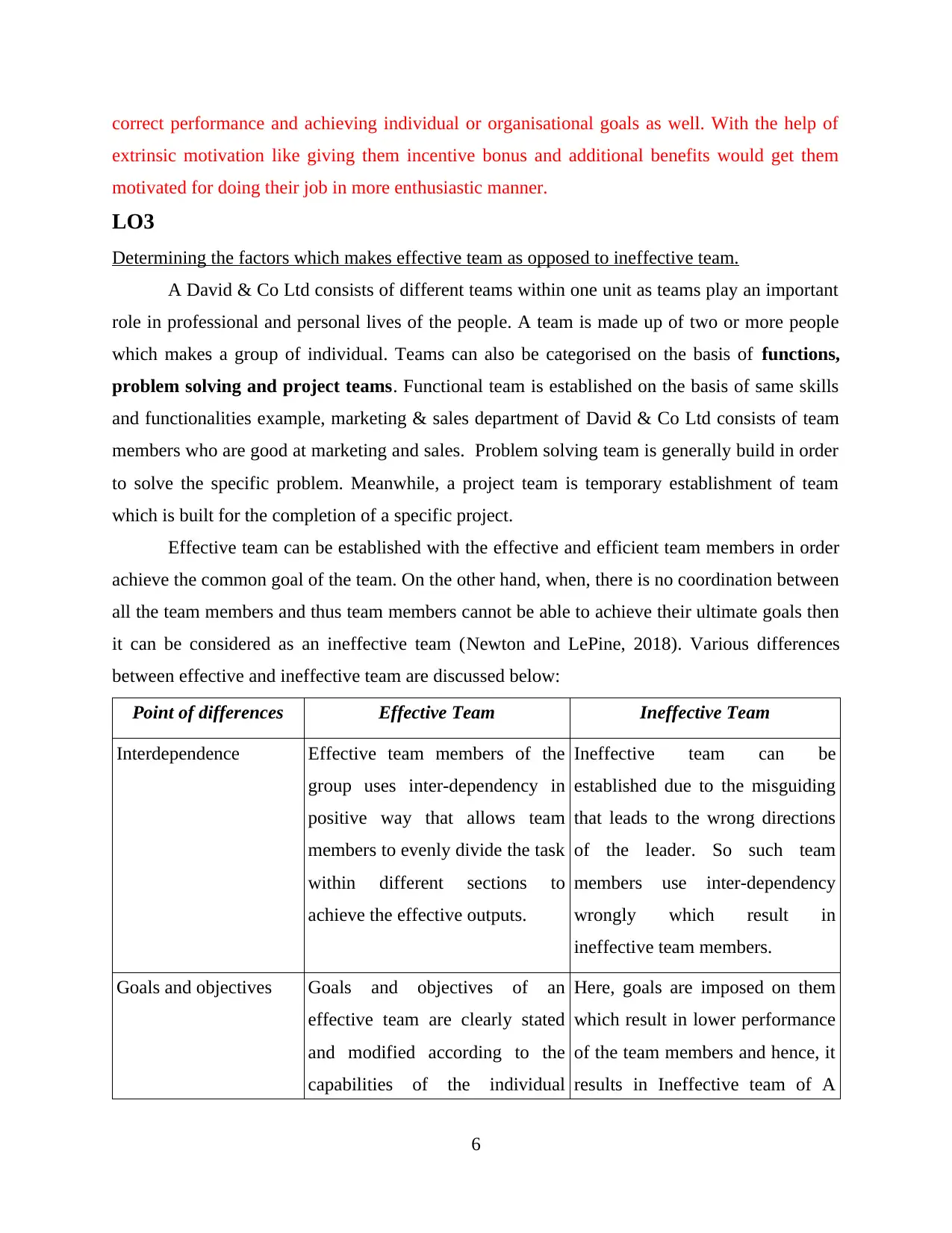
correct performance and achieving individual or organisational goals as well. With the help of
extrinsic motivation like giving them incentive bonus and additional benefits would get them
motivated for doing their job in more enthusiastic manner.
LO3
Determining the factors which makes effective team as opposed to ineffective team.
A David & Co Ltd consists of different teams within one unit as teams play an important
role in professional and personal lives of the people. A team is made up of two or more people
which makes a group of individual. Teams can also be categorised on the basis of functions,
problem solving and project teams. Functional team is established on the basis of same skills
and functionalities example, marketing & sales department of David & Co Ltd consists of team
members who are good at marketing and sales. Problem solving team is generally build in order
to solve the specific problem. Meanwhile, a project team is temporary establishment of team
which is built for the completion of a specific project.
Effective team can be established with the effective and efficient team members in order
achieve the common goal of the team. On the other hand, when, there is no coordination between
all the team members and thus team members cannot be able to achieve their ultimate goals then
it can be considered as an ineffective team (Newton and LePine, 2018). Various differences
between effective and ineffective team are discussed below:
Point of differences Effective Team Ineffective Team
Interdependence Effective team members of the
group uses inter-dependency in
positive way that allows team
members to evenly divide the task
within different sections to
achieve the effective outputs.
Ineffective team can be
established due to the misguiding
that leads to the wrong directions
of the leader. So such team
members use inter-dependency
wrongly which result in
ineffective team members.
Goals and objectives Goals and objectives of an
effective team are clearly stated
and modified according to the
capabilities of the individual
Here, goals are imposed on them
which result in lower performance
of the team members and hence, it
results in Ineffective team of A
6
extrinsic motivation like giving them incentive bonus and additional benefits would get them
motivated for doing their job in more enthusiastic manner.
LO3
Determining the factors which makes effective team as opposed to ineffective team.
A David & Co Ltd consists of different teams within one unit as teams play an important
role in professional and personal lives of the people. A team is made up of two or more people
which makes a group of individual. Teams can also be categorised on the basis of functions,
problem solving and project teams. Functional team is established on the basis of same skills
and functionalities example, marketing & sales department of David & Co Ltd consists of team
members who are good at marketing and sales. Problem solving team is generally build in order
to solve the specific problem. Meanwhile, a project team is temporary establishment of team
which is built for the completion of a specific project.
Effective team can be established with the effective and efficient team members in order
achieve the common goal of the team. On the other hand, when, there is no coordination between
all the team members and thus team members cannot be able to achieve their ultimate goals then
it can be considered as an ineffective team (Newton and LePine, 2018). Various differences
between effective and ineffective team are discussed below:
Point of differences Effective Team Ineffective Team
Interdependence Effective team members of the
group uses inter-dependency in
positive way that allows team
members to evenly divide the task
within different sections to
achieve the effective outputs.
Ineffective team can be
established due to the misguiding
that leads to the wrong directions
of the leader. So such team
members use inter-dependency
wrongly which result in
ineffective team members.
Goals and objectives Goals and objectives of an
effective team are clearly stated
and modified according to the
capabilities of the individual
Here, goals are imposed on them
which result in lower performance
of the team members and hence, it
results in Ineffective team of A
6
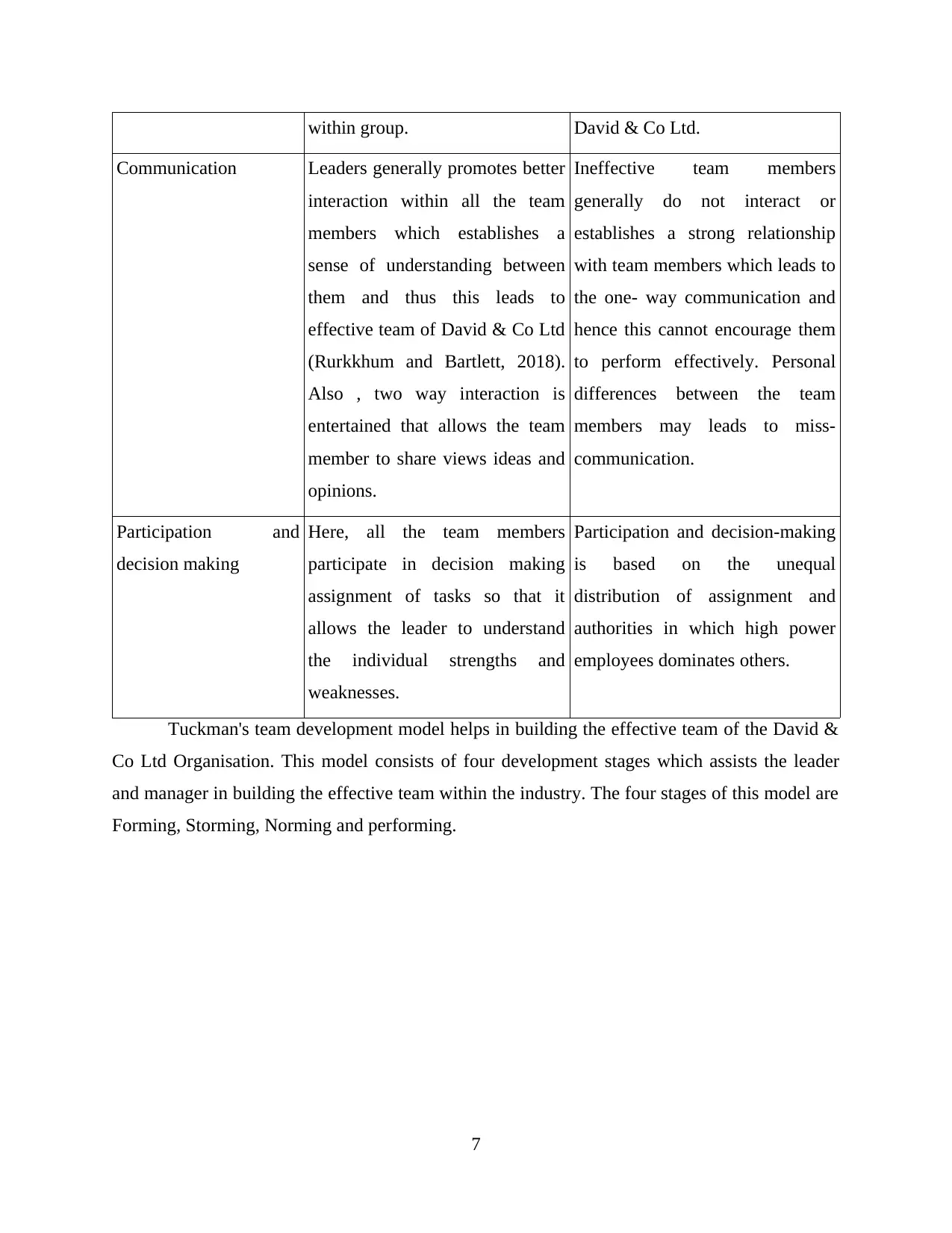
within group. David & Co Ltd.
Communication Leaders generally promotes better
interaction within all the team
members which establishes a
sense of understanding between
them and thus this leads to
effective team of David & Co Ltd
(Rurkkhum and Bartlett, 2018).
Also , two way interaction is
entertained that allows the team
member to share views ideas and
opinions.
Ineffective team members
generally do not interact or
establishes a strong relationship
with team members which leads to
the one- way communication and
hence this cannot encourage them
to perform effectively. Personal
differences between the team
members may leads to miss-
communication.
Participation and
decision making
Here, all the team members
participate in decision making
assignment of tasks so that it
allows the leader to understand
the individual strengths and
weaknesses.
Participation and decision-making
is based on the unequal
distribution of assignment and
authorities in which high power
employees dominates others.
Tuckman's team development model helps in building the effective team of the David &
Co Ltd Organisation. This model consists of four development stages which assists the leader
and manager in building the effective team within the industry. The four stages of this model are
Forming, Storming, Norming and performing.
7
Communication Leaders generally promotes better
interaction within all the team
members which establishes a
sense of understanding between
them and thus this leads to
effective team of David & Co Ltd
(Rurkkhum and Bartlett, 2018).
Also , two way interaction is
entertained that allows the team
member to share views ideas and
opinions.
Ineffective team members
generally do not interact or
establishes a strong relationship
with team members which leads to
the one- way communication and
hence this cannot encourage them
to perform effectively. Personal
differences between the team
members may leads to miss-
communication.
Participation and
decision making
Here, all the team members
participate in decision making
assignment of tasks so that it
allows the leader to understand
the individual strengths and
weaknesses.
Participation and decision-making
is based on the unequal
distribution of assignment and
authorities in which high power
employees dominates others.
Tuckman's team development model helps in building the effective team of the David &
Co Ltd Organisation. This model consists of four development stages which assists the leader
and manager in building the effective team within the industry. The four stages of this model are
Forming, Storming, Norming and performing.
7
⊘ This is a preview!⊘
Do you want full access?
Subscribe today to unlock all pages.

Trusted by 1+ million students worldwide
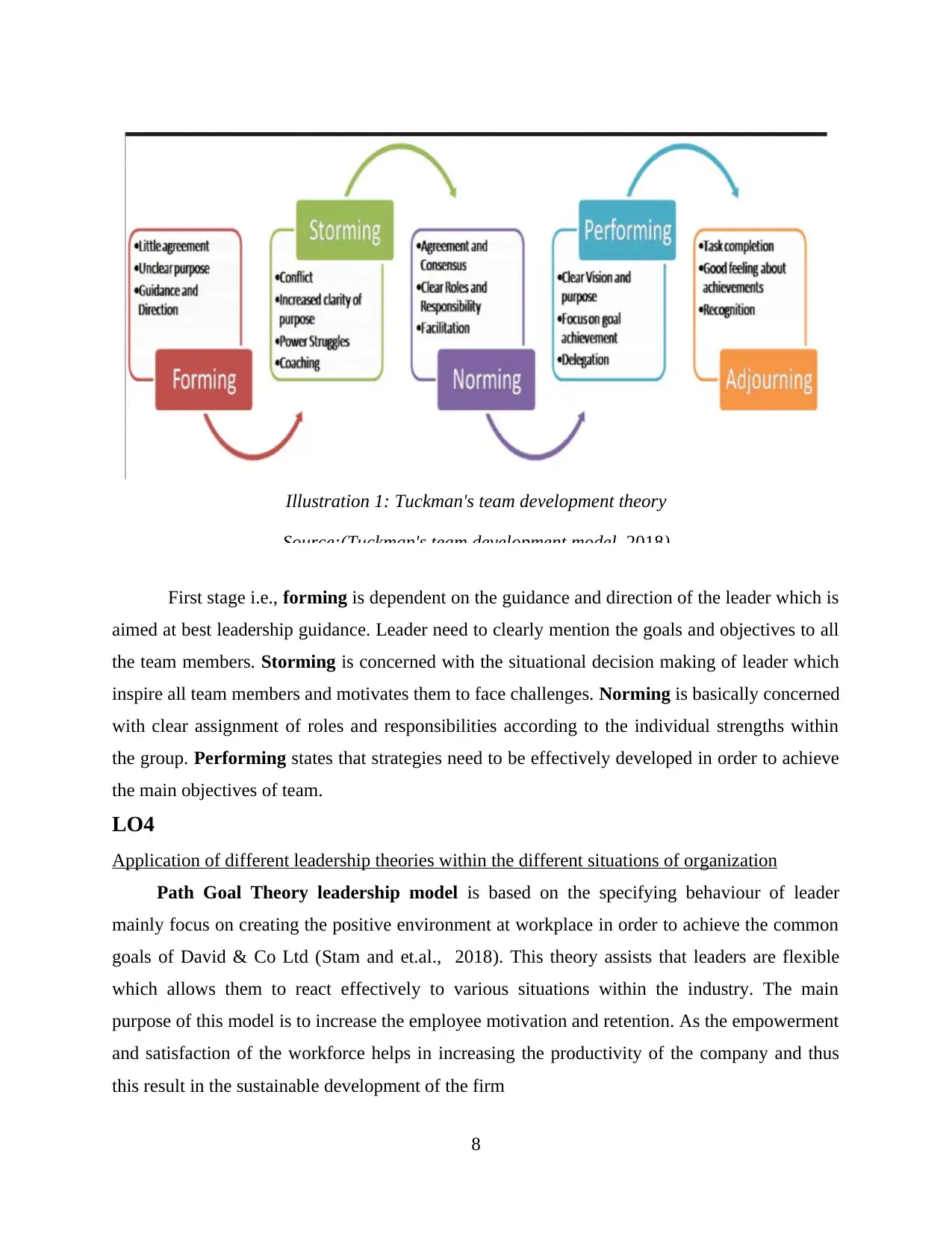
First stage i.e., forming is dependent on the guidance and direction of the leader which is
aimed at best leadership guidance. Leader need to clearly mention the goals and objectives to all
the team members. Storming is concerned with the situational decision making of leader which
inspire all team members and motivates them to face challenges. Norming is basically concerned
with clear assignment of roles and responsibilities according to the individual strengths within
the group. Performing states that strategies need to be effectively developed in order to achieve
the main objectives of team.
LO4
Application of different leadership theories within the different situations of organization
Path Goal Theory leadership model is based on the specifying behaviour of leader
mainly focus on creating the positive environment at workplace in order to achieve the common
goals of David & Co Ltd (Stam and et.al., 2018). This theory assists that leaders are flexible
which allows them to react effectively to various situations within the industry. The main
purpose of this model is to increase the employee motivation and retention. As the empowerment
and satisfaction of the workforce helps in increasing the productivity of the company and thus
this result in the sustainable development of the firm
8
Illustration 1: Tuckman's team development theory
Source:(Tuckman's team development model, 2018)
aimed at best leadership guidance. Leader need to clearly mention the goals and objectives to all
the team members. Storming is concerned with the situational decision making of leader which
inspire all team members and motivates them to face challenges. Norming is basically concerned
with clear assignment of roles and responsibilities according to the individual strengths within
the group. Performing states that strategies need to be effectively developed in order to achieve
the main objectives of team.
LO4
Application of different leadership theories within the different situations of organization
Path Goal Theory leadership model is based on the specifying behaviour of leader
mainly focus on creating the positive environment at workplace in order to achieve the common
goals of David & Co Ltd (Stam and et.al., 2018). This theory assists that leaders are flexible
which allows them to react effectively to various situations within the industry. The main
purpose of this model is to increase the employee motivation and retention. As the empowerment
and satisfaction of the workforce helps in increasing the productivity of the company and thus
this result in the sustainable development of the firm
8
Illustration 1: Tuckman's team development theory
Source:(Tuckman's team development model, 2018)
Paraphrase This Document
Need a fresh take? Get an instant paraphrase of this document with our AI Paraphraser
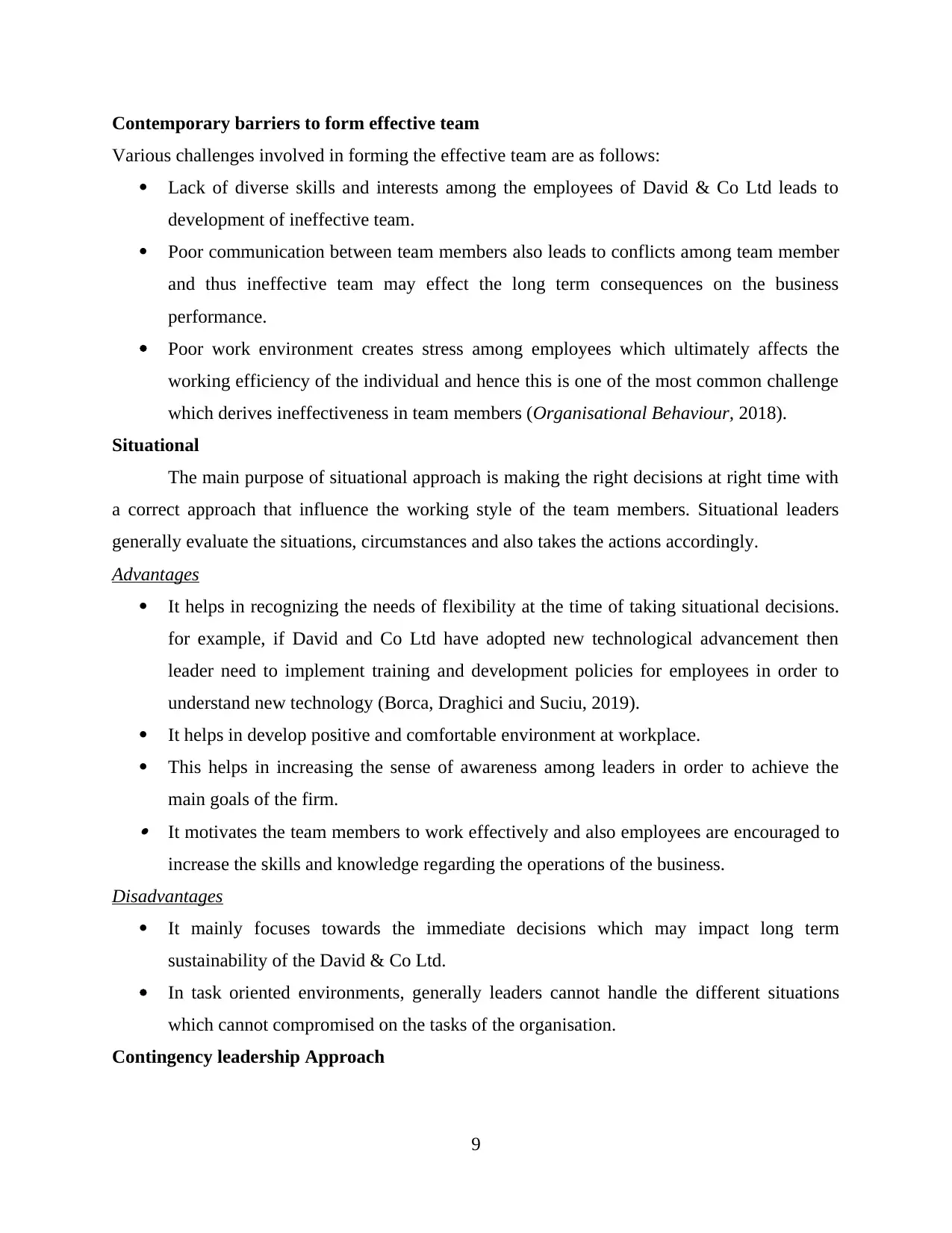
Contemporary barriers to form effective team
Various challenges involved in forming the effective team are as follows:
Lack of diverse skills and interests among the employees of David & Co Ltd leads to
development of ineffective team.
Poor communication between team members also leads to conflicts among team member
and thus ineffective team may effect the long term consequences on the business
performance.
Poor work environment creates stress among employees which ultimately affects the
working efficiency of the individual and hence this is one of the most common challenge
which derives ineffectiveness in team members (Organisational Behaviour, 2018).
Situational
The main purpose of situational approach is making the right decisions at right time with
a correct approach that influence the working style of the team members. Situational leaders
generally evaluate the situations, circumstances and also takes the actions accordingly.
Advantages
It helps in recognizing the needs of flexibility at the time of taking situational decisions.
for example, if David and Co Ltd have adopted new technological advancement then
leader need to implement training and development policies for employees in order to
understand new technology (Borca, Draghici and Suciu, 2019).
It helps in develop positive and comfortable environment at workplace.
This helps in increasing the sense of awareness among leaders in order to achieve the
main goals of the firm. It motivates the team members to work effectively and also employees are encouraged to
increase the skills and knowledge regarding the operations of the business.
Disadvantages
It mainly focuses towards the immediate decisions which may impact long term
sustainability of the David & Co Ltd.
In task oriented environments, generally leaders cannot handle the different situations
which cannot compromised on the tasks of the organisation.
Contingency leadership Approach
9
Various challenges involved in forming the effective team are as follows:
Lack of diverse skills and interests among the employees of David & Co Ltd leads to
development of ineffective team.
Poor communication between team members also leads to conflicts among team member
and thus ineffective team may effect the long term consequences on the business
performance.
Poor work environment creates stress among employees which ultimately affects the
working efficiency of the individual and hence this is one of the most common challenge
which derives ineffectiveness in team members (Organisational Behaviour, 2018).
Situational
The main purpose of situational approach is making the right decisions at right time with
a correct approach that influence the working style of the team members. Situational leaders
generally evaluate the situations, circumstances and also takes the actions accordingly.
Advantages
It helps in recognizing the needs of flexibility at the time of taking situational decisions.
for example, if David and Co Ltd have adopted new technological advancement then
leader need to implement training and development policies for employees in order to
understand new technology (Borca, Draghici and Suciu, 2019).
It helps in develop positive and comfortable environment at workplace.
This helps in increasing the sense of awareness among leaders in order to achieve the
main goals of the firm. It motivates the team members to work effectively and also employees are encouraged to
increase the skills and knowledge regarding the operations of the business.
Disadvantages
It mainly focuses towards the immediate decisions which may impact long term
sustainability of the David & Co Ltd.
In task oriented environments, generally leaders cannot handle the different situations
which cannot compromised on the tasks of the organisation.
Contingency leadership Approach
9
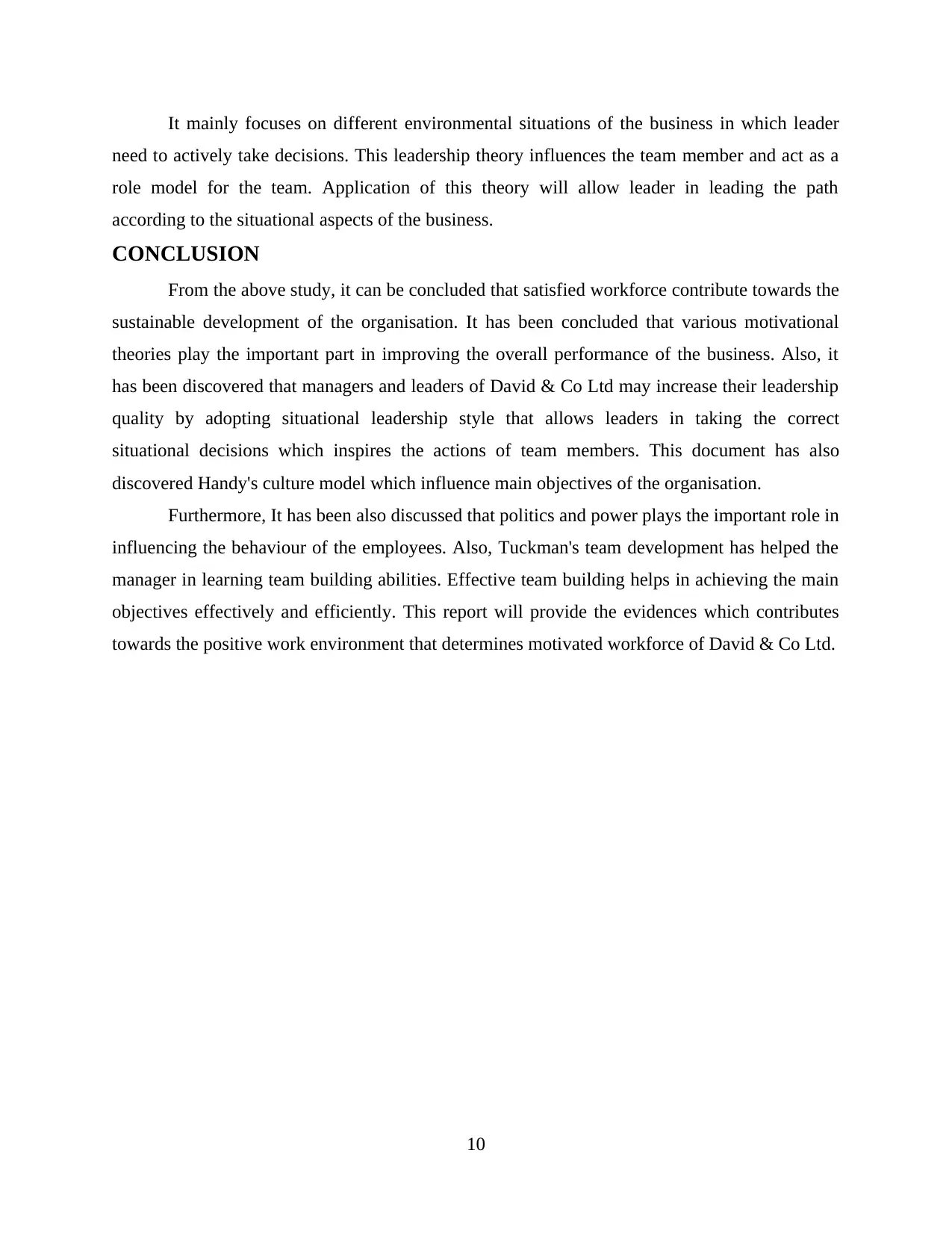
It mainly focuses on different environmental situations of the business in which leader
need to actively take decisions. This leadership theory influences the team member and act as a
role model for the team. Application of this theory will allow leader in leading the path
according to the situational aspects of the business.
CONCLUSION
From the above study, it can be concluded that satisfied workforce contribute towards the
sustainable development of the organisation. It has been concluded that various motivational
theories play the important part in improving the overall performance of the business. Also, it
has been discovered that managers and leaders of David & Co Ltd may increase their leadership
quality by adopting situational leadership style that allows leaders in taking the correct
situational decisions which inspires the actions of team members. This document has also
discovered Handy's culture model which influence main objectives of the organisation.
Furthermore, It has been also discussed that politics and power plays the important role in
influencing the behaviour of the employees. Also, Tuckman's team development has helped the
manager in learning team building abilities. Effective team building helps in achieving the main
objectives effectively and efficiently. This report will provide the evidences which contributes
towards the positive work environment that determines motivated workforce of David & Co Ltd.
10
need to actively take decisions. This leadership theory influences the team member and act as a
role model for the team. Application of this theory will allow leader in leading the path
according to the situational aspects of the business.
CONCLUSION
From the above study, it can be concluded that satisfied workforce contribute towards the
sustainable development of the organisation. It has been concluded that various motivational
theories play the important part in improving the overall performance of the business. Also, it
has been discovered that managers and leaders of David & Co Ltd may increase their leadership
quality by adopting situational leadership style that allows leaders in taking the correct
situational decisions which inspires the actions of team members. This document has also
discovered Handy's culture model which influence main objectives of the organisation.
Furthermore, It has been also discussed that politics and power plays the important role in
influencing the behaviour of the employees. Also, Tuckman's team development has helped the
manager in learning team building abilities. Effective team building helps in achieving the main
objectives effectively and efficiently. This report will provide the evidences which contributes
towards the positive work environment that determines motivated workforce of David & Co Ltd.
10
⊘ This is a preview!⊘
Do you want full access?
Subscribe today to unlock all pages.

Trusted by 1+ million students worldwide
1 out of 14
Related Documents
Your All-in-One AI-Powered Toolkit for Academic Success.
+13062052269
info@desklib.com
Available 24*7 on WhatsApp / Email
![[object Object]](/_next/static/media/star-bottom.7253800d.svg)
Unlock your academic potential
Copyright © 2020–2025 A2Z Services. All Rights Reserved. Developed and managed by ZUCOL.





